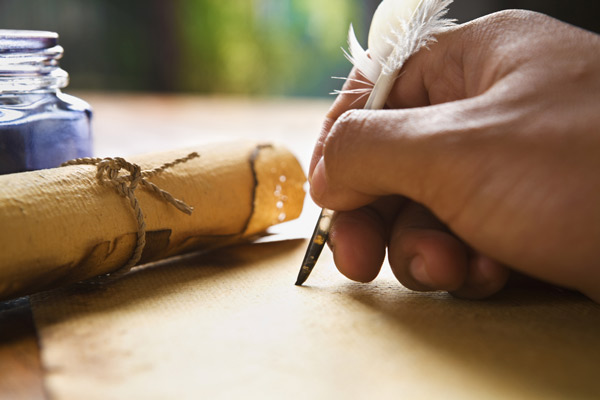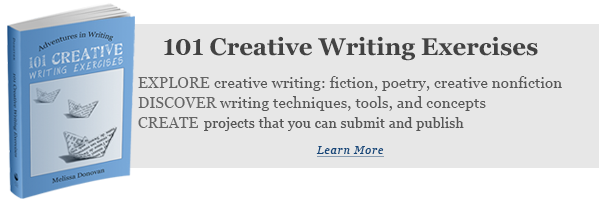Today’s post is from my book, 101 Creative Writing Exercises, which is available from your favorite online bookseller in paperback or as an ebook. This is from chapter six: “Storytelling,” and it’s called “Chekhov’s Gun.” Enjoy!
Chekhov’s Gun
Chekhov’s Gun is a literary device in which an element is mentioned in a story and its purpose or significance becomes clear later. For example, early in a story, the narrative mentions that the hero carries a knife. Later, he uses that knife to defend himself in a fight. If the knife hadn’t been mentioned earlier, it might feel like an object of convenience. On the other hand, if the knife is mentioned but he never uses it, the reader might feel cheated after anticipating a good knife fight.
The real purpose of Chekhov’s Gun is to remind writers that they have an obligation to fulfill all promises made to readers. If the narrative mentions that the hero carries a knife, the reader expects that he will, at some point, use it. If he doesn’t, the writer has failed to fulfill a promise. In other words: don’t pepper your story with unnecessary, insignificant, or meaningless elements. Make everything count!
The term “Chekhov’s Gun” comes from a letter from Anton Chekhov to Aleksandr Semenovich Lazarev (also known as A.S. Gruzinsky) in which he said, “One must not put a loaded rifle on the stage if no one is thinking of firing it.”
The Exercise
Write a short scene and introduce two objects right at the opening of the scene. Make sure one of the objects is used later in the scene, but leave the other object unused. Note that these objects will not be part of the descriptive content. For example, if the scene includes a description of a room and mentions a chair in the corner, you don’t have to use the chair later because it is part of the setting description.
Let your scene sit overnight and then read it back the next day. Notice how the unused object lingers in the reader’s mind in an unpleasant way. Once you’re done, feel free to revise and edit out the unnecessary object or add action in which it becomes significant.
Tips: Differentiating between what constitutes a necessary or unnecessary element can be tricky. In some cases, a knife that is mentioned may not need to be played later (for example, a knife might be mentioned in the context of one of the characters eating). In other cases, a chair that is mentioned will need to be played. A woman might carry a purse, but that doesn’t mean she needs to retrieve anything from it because most women carry purses. On the other hand, if she’s carrying a file marked “TOP SECRET,” the reader expects to eventually be let in on the contents of the file.
Variations: Go through a story you’ve already written and look for instances in which you included unnecessary or misleading elements.
Applications: The difference between excellence and mediocrity in storytelling often lies in the details. Chekhov’s Gun is one of the many details that could cause a story to lose credibility with readers. Therefore, checking your narrative for unnecessary or irrelevant elements will strengthen and improve your work.






Thanks for naming the device as I use it all the time in writing non-fiction. For instance, “…that should have given me pause.” Or, “Little did I know.” Maybe not exactly the same but foreshadows an upcoming event so the reader has some perspective on it. Ver useful.
Yes, it is a bit like foreshadowing. If the gun doesn’t go off, maybe it could be considered incorrect or misleading foreshadowing. Thanks, Tony!
Great advice. I have had this happen to me when my characters decide to include something I did not think of myself. So far, so good … all loose ends have tied up.
That’s great! Sometimes, I write a scene and three scenes later I realize that I forgot to tie something up. Sometimes, it’s something I left out. Other times, it’s something I shouldn’t have mentioned at all. That’s what editing is for!
I don’t think the writer has necessarily failed to deliver on a promise if he/she chooses to not use some pre-existing element of the story. If every potential “chekhov’s gun” of the story was used the story would in a way become predictable. Not all the loose ends should tie up neatly, though part of a good story is that most of them do.
Jarkko
Hi Jarkko,
This is more about knowing which loose ends need to be tied up and which objects need to be played. The gun is the best example because in a story, if you show the character polishing a gun in the first act, there is an expectation that it will be used before the story ends. Are there stories where that wouldn’t be required? Of course, but this is a general rule, not a law written in stone. There are always exceptions.
I would say all loose ends need to be tied up but the author needs to be cognizant of what constitutes a loose end. Here’s an example: in the TV show LOST, there was a mysterious, ancient statue. It was part of the setting of the show. Viewers became curious about it. Who built it? Why? The show ended without answering those questions, and some people thought that the producers had left loose ends open. However, the statue was not pertinent to the plot. It was a piece of the setting, part of the description. Its purpose was to show that the setting was ancient, not to create a new story tangent about the history of some piece of the setting.
Much of this is subjective, of course. The idea behind Chekhov’s Gun is to be aware of promises made to the reader and fulfill them. There are many elements of a story that won’t play a significant role, that won’t appear again later or be described in detail. How those elements are presented (as objects of importance vs. part of the setting, for example) determines whether a promise has been made.
I like your explanation of Chekhow’s Gun. In particular, I liked the line, “The real purpose of Chekhov’s Gun is to remind writers that they have an obligation to fulfill all promises made to readers.”
Thanks, Janet! I think those promises that a story makes are pretty important, and as a reader or fan, I’m always disappointed when they go unfulfilled.